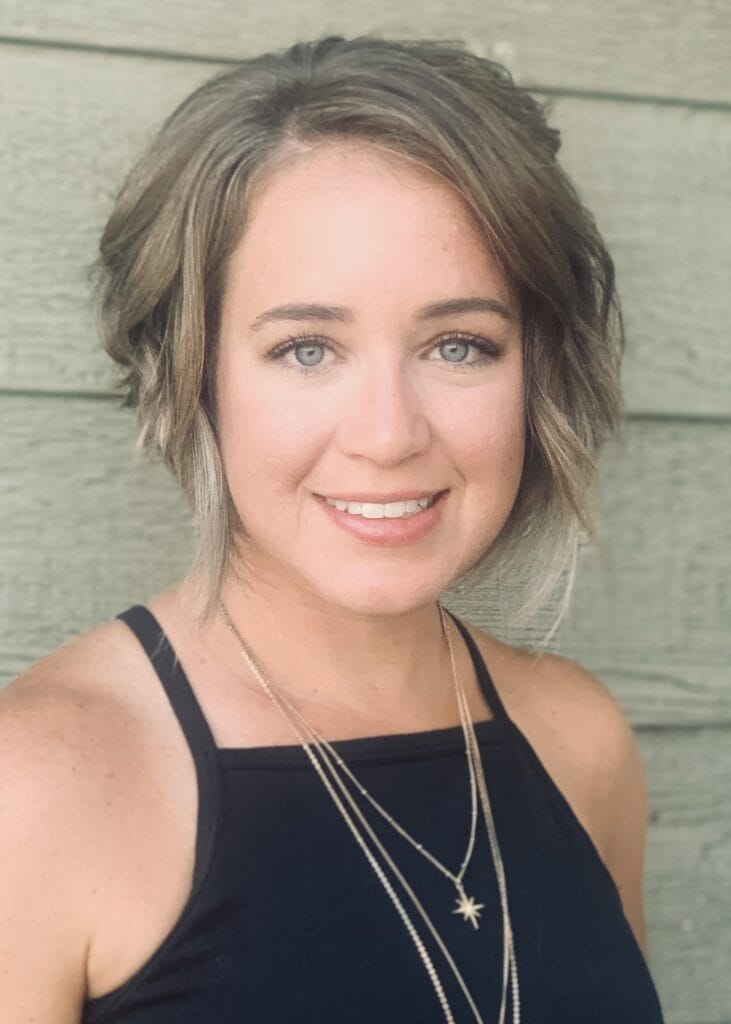
Hollie Fleming, CCC-SLP, grew up in Springfield, Missouri. She graduated with her speech-language pathology degree from Missouri State University and has been a practicing SLP for 12 years. She’s also a certified yoga instructor. Hollie travels with her husband who is in the military. They have a twelve-year-old daughter. Their family currently lives in South Dakota. Hollie joined the PL Care Network in 2018.
Can you tell us a little about yourself, where you live, your hobbies?
I enjoy practicing yoga and taking yoga classes. My family is an outdoor family so we enjoy hiking, being outdoors, and gardening. I’m kind of a techie so I enjoy creating materials for my practice on the computer—graphic design, just anything that is visual. Most of my materials are individualized for my students. I’ve had my eye on starting a Teachers Pay Teachers store. I’m hoping I’ll have some extra time in the summer. We’ll see.
What inspired you to become an SLP?
I was originally interested in becoming a deaf educator. As I started taking classes to be a deaf educator, I realized that I was so interested and most excited about helping deaf adults and deaf children communicate. I got to work in a clinic and the communication portion was just my passion. I couldn’t stop thinking about it. I had so many ideas and that led me into getting a speech language pathology degree at Missouri State U. I’ve been practicing for a little over 12 years now.
What made you want to be a teletherapist with PL?
My husband is in the Air Force and our family has lived in three different states. PresenceLearning provides an opportunity for me to maintain connections to places we have called home. I am so grateful for the opportunity to provide speech and language services to clients from anywhere the Air Force sends us.
Could you walk us through your daily routine? A “day in the life of a PL therapist” if you will?
My day begins with a hot cup of coffee. While my daughter gets ready for school I catch up on emails, sync my calendars, and plan my day. After I drop her off at school I fill my essential oil diffuser with orange and lavender oil, open the window shades, and begin seeing students. If I get a break around lunch I do a little office yoga and eat a snack. I finish up with scheduled students just before my daughter gets home from school. The evenings and weekends are for family, but if I need to finish up on report writing or paperwork, I can always work that in early mornings or in the late evenings.
Can you tell us about your caseload?
My caseload is very diverse. I am working in both Illinois and Alaska. I am currently living in South Dakota so I am playing the time zone game. In the mornings I see my students in the Central time zone. Those students have a lot of communication needs. Most of them are nonverbal and use high tech and low tech communication devices so that’s a lot of fun and a big challenge to come up with novel activities that will keep their interests as well as targeting their goals.
Later in the morning I move over to the Alaska time zone. There most of my caseload is middle schoolers. I am working with some students who have a lot of communication needs in an applied behavior analysis classroom. They are using high tech and low tech communication devices, LAMP, and Proloquo2go (software designed to assist communications). The rest of that caseload is middle school students. I have a lot of language goals that we’re targeting. And then I have a few elementary-age students spread here and there.
How do you manage the different time zones? Do you have any tips or tricks?
I live in Mountain time zone and I work in Central time zone and Alaska time zone. I rely on my Google calendar. When I make an appointment, I have a method. I make sure I put the appointment in using their timezone—there’s a drop down box in Google calendar and I select their time zone. My appointment is in their time zone so if I invite someone to the calendar event, the text reads in their time zone. I also color code my Google calendar. Each school has a color and that helps me to keep everything organized.
What do you enjoy about being a provider with PL?
I enjoy the one-on-one time with my students. Teletherapy enables me to have the students’ full attention for the entire session. We are always face-to-face. There are fewer distractions during teletherapy sessions than in a brick-and-mortar setting. The teletherapy service delivery model is so motivating for students. We can get more work done with less behavior management. That means better outcomes as the students’ reach their goals at rapid speed.
Can you tell us more about how you create your own materials?
Because I really like for my materials to be individualized, I use a combination of tools. I use SymbolStix. If my student is using a high tech communication device, I make the materials from their symbol system that they are using. I use a lot of real life photos. I love adding orthographic cues so lots of words. Usually I use Microsoft Word. I try to keep it simple. I work on a Mac so it’s easy to convert Word documents into a PDF for use on the platform. I pull from a variety of materials and I try to make them as familiar to the student as possible. Part of making the materials individualized for them is just showing them that you respect them. You’re making a connection with them and you’re telling them that their thoughts are important. And isn’t that what communication is all about? Once they know that you think that what they’re thinking and what they’re feeling is important, then you have all the buy-in.
What are your communication preferences? Which channels do you use?
I am a multimodality communicator. I like to use email. I like to use phone calls. At the beginning of accepting an assignment, I find out what the best way to communicate with my staff, with my learning partners is and then I always go there. So if I am empowering them to be a leader in our communication, then that’s the first step I would say. I ask a lot of questions. What’s the best time of day to call? If I am having some barriers communicating with someone, I like to be up front—when can we talk, do we need to set an appointment—I have these times available, what’s the best way to get in touch with you?
What do you find most challenging about being a teletherapist?
The most challenging part of being a teletherapist is missing out on the parades, the popcorn parties, community events, and the field trips. I make a special effort to make connections with the students and staff I work with by wearing their school hoodie during sessions and looking at pictures with them of things that are happening in their schools and communities.
What did you do before you joined PL when you had to move?
Moving frequently has challenges depending on what state you’re moving to and what the need for SLPs is in that state. My last move was a huge challenge. I had to piece together PRN work. Initially I filled in for a maternity leave for 8 weeks. When that was over they wanted to place me but they just didn’t have an open position. It was an area where there were a lot of schools that were pumping out SLPs right and left and they would work for a lower wage than someone with my experience really wanted to accept. So I ended up working in a few different settings as needed.
I worked at a skilled nursing facility for a few hours a week. The same company asked me to fill in for another maternity leave later. So it was a lot of piece work where we lived at this last assignment. I just knew in my mind, I’d been thinking about teletherapy for a while. When we started hearing the rumors that we might be moving again, I felt like it was the right time to look into what my options were and I am so grateful because the move was so smooth. They picked up our household goods. I worked at the kitchen table for a while. Then when we moved we took our time. We stayed at a waterpark hotel on the way up. I still could work and I still had the peace of mind. I could focus on my family and my family’s transition to a new state instead of focusing on finding a new job and figuring out where I wanted to work. This has been such a blessing for our family.
Can you talk about the cross licensing process and offer any advice?
The cross licensing process has been a major challenge and a big stress for our family. My advice is to write letters to your legislators. When we moved to South Dakota I had enough notice that I prepared early. I submitted my applications ahead of time. I talked to people to find out what exactly I needed to do. So the process for South Dakota was fairly seamless. But I still was involved because SD just recently passed a bill to expedite military spouses’ professional licensing. I was asked to write the legislators. I prepared testimony for the hearing. They didn’t get to me, but I had the testimony prepared. I emailed between 13 and 18 legislators, and I got a response from most of them. These legislators have a lot on their plates. When you send or submit a personal story, they can make a connection and it’s in the front of their mind. My advice is to email your legislators. Talk to your local Chamber of Commerce—we military spouses bring so much to the community and have so many gifts to bring. And they want us. We just have to make those communication connections with the people who care and who have an investment in what we have to offer.
One big challenge I faced during this past move was getting all 3 of my current state licenses verified. This process can take a significant amount of time. One solution would be an interstate compact for SLPs. An interstate compact would decrease the amount of paperwork and time that it takes to obtain licensure upon moving to another state.␌
Is there anything you especially appreciate about the PL platform?
I have been so impressed with everyone’s professionalism, and with the technical support staff. They’re so polite, patient, helpful. Patient! Being able to document during the session is priceless.
What’s one piece of advice you would offer a therapist who’s considering transitioning to telepractice?
Come into it with an open mind. Be willing to be flexible and be willing to learn and you absolutely will be rewarded. The kids are amazing. The other colleagues I work with are amazing. It’s different. It’s a change but if you come into it with an open heart and an open mind, you may never go back to a brick and mortar setting.
Are there any last comments you’d like to share?
I’m just so excited to be an SLP and to have this opportunity to provide teletherapy services.
Are you interested in joining the PL Care Network? Visit our Provider page to submit your application today!



